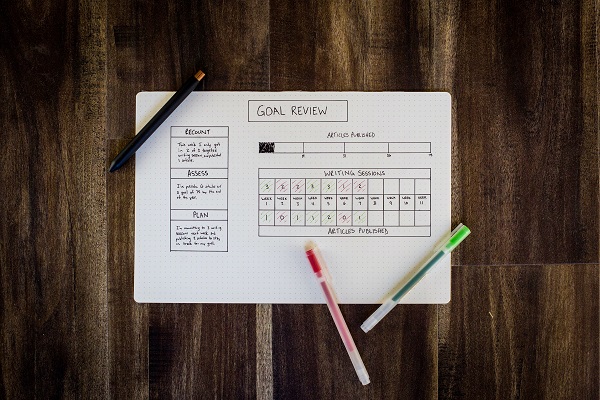Getting started on a novel can be the hardest step. Writers the world over have often debated the best way to embark on a new literary endeavour.
The novel-writing process tends to follow one of two patterns: plotting or pantsing.
For those unfamiliar with these terms, a ‘plotter’ is a writer who follows a strict plan and tends to put in a lot of background work before writing the opening lines of their novel.
On the other hand, a ‘pantser’ – whose moniker comes from the phrase to fly by the seat of your pants – will start writing and see what happens.
For plotters, the pantser’s method sounds like chaos; for pantsers, the plotter’s approach is tedious. But is one better than the other? After all, they both produce the same outcome – a first draft.
If you’re unsure of how to get started, read on for a look at the pros and cons of each approach and decide which method works best for you and your project.
Plotting: The Pros
Clear direction
Never underestimate the power of clarity. Knowing where your novel is going and, more importantly, how it’s going to get there can be the difference between getting to the end and getting lost along the way.
A typical plotter may break down their outline into a precise three-act structure (or a detailed plan of how to subvert it), complete with scenes detailing each story beat.
This helps give the writer a clear indication of what they are doing and when they need to do it, as well as the why and how.
Having this direction from the get-go helps propel work forward more quickly, as there is less time to second-guess where the story is headed once you start writing.
It’s also a great tool for writers who choose not to work linearly: that is, from story start to finish.
If you’re more compelled to write scenes when they’re most appealing to you and not when they chronologically occur, having a clear breakdown of what will happen and when will help everything fit together, regardless of what order you actually write in.
Better understanding of characters
Crafting characters with believable faults, clear motivations and fleshed-out backstories is integral to holding a reader’s interest throughout the length of a narrative.
After all, a high-stakes plot with plenty of twists and turns means nothing when your audience doesn’t care whether the protagonist succeeds or fails.
Many plotters wouldn’t dare put pen to paper without folders of information detailing their characters’ intricacies.
Character profiles covering everything from physical description to morals and personality type indicators are clear favourites when it comes to the plotter’s character-building process.
So why does this help?
Fully conceived characters come to life in the readers’ minds. The more you know about your characters as the author, the more authentic they become – even if some of the data never makes it onto the page.
It also helps with consistency. Keeping a file of personal traits and trivia means you’re more likely to avoid slip-ups that may see a character with blonde hair in one chapter becoming brunette a few pages later.

Less likely to become stuck
A good novel outline is the plotter’s map to success, always there to point them in the right direction.
The traditional plotter will know exactly what will happen and when before the opening sentences are ever penned.
The beauty of this is that even if something unexpected happens – which, let’s face it, it might – a well-crafted plan will help get things back on track.
Writer’s block is the bane of all literary creatives and can strike down even the most motivated, passionate and organised of us.
There is no single cause of the dreaded block (and no single cure), but Jane Friedman, editor of The Hot Sheet, a newsletter for authors, describes losing your way as being one of the top five reasons writers stop writing.
When a plotter stumbles across this type of obstacle, all they need do is take a deep breath and consult their notes to see what went wrong.
Having an outline on hand enables you to refocus by reminding you of the end goal and what steps you need to take to get there if you happen to get lost along the way.
Fewer rewrites
Provided everything goes to plan, a well-plotted draft is likely to require less extensive rewrites than a freshly completed manuscript of the pantser variety.
Plot holes and the need for a structural overhaul are usually not as big a part of the plotter’s editing journey, as they have carefully considered the overarching storyline from the get-go.
This gives plotters more editing time to focus on the line-by-line, which will no doubt need some pruning or plumping.
Coming armed with a huge stockpile of research, world-building and character profiles, it can be tempting for some plotters to show their hard work by including it all in the manuscript – so this might need to be stripped back in the editing stage.
Other plotters may use the first draft to get through the plot they have crafted, and, upon their second review, fill in the descriptions and subtle character interactions that assist in building tension and adding flavour to the storyline.
While plotting doesn’t fully remove the need for rewrites – no first draft is perfect – it does provide the writer with a stronger, more cohesive foundation that enables editing time to be used for strengthening the story, rather than fixing it.
Plotting: The Cons
More work upfront
Outlining a novel is a huge undertaking, especially if you’re a new writer looking to turn your first bolt of inspiration into a full-length manuscript.
While having a clear picture of what you want to write certainly has its benefits, plotting is hard work. It can be a tiring, time-consuming approach, which demands that you lock down your story’s endgame right off the bat.
This can be very intimidating if all you’ve got to work with is the tiniest kernel of an idea. Where do you even start? Plot? Character arcs? Themes? World-building?
Unlike the pantser who just dives in at Chapter One, the plotter is determined to get everything in order before pushing out to sea. But facing that mountain of prep-work can be daunting, and could even deter some writers from getting started altogether.
Plotting is not for the faint-hearted, particularly if you’re working in a complex genre like crime or fantasy, and/or planning to write a series. It can leave your head feeling like it’s about to explode with all the ‘what ifs’ that need addressing.
So, be wary of going too hard, too fast: the last thing you want to do is burn out before you start.
Not as easy to measure progress
If you’re someone who thrives on clear-cut progress to keep their motor running, plotting may not be the path for you.
Plotting can feel like a thankless job, as much of the hard work is being done behind the scenes before the writing starts, with no concrete measure of output.
Even if you know your characters inside out, have completed the most comprehensive personality quizzes and crafted a compelling backstory, it can all feel for naught if you’re yet to see the character in action.
Despite hours of work and dedication, even the most thorough plotter can be trapped under the debilitating shroud of uncertainty.
After all, if there’s no novel, what is the point?
Goal-orientated writers tend to struggle during a planning phase as ‘outline chapter one’ looks and feels very different to ‘write chapter one’.
Even if it’s physically recorded on notes or spreadsheets, a plan is still just an idea, a guideline, and not an actual piece of writing.
As such, many would-be plotters may be left feeling unsatisfied and disheartened – and may lose interest in their project altogether.

Plans can unravel
Sometimes things just don’t go to plan. Maybe your fleshed-out character developed a mind of their own and pulled the wrong thread that sent your entire plot unravelling right before your eyes.
Regardless of how meticulous you were in your outline, unfortunately, snags happen. If you’re a plotter who had every piece of their novel carefully knitted together, you may just find yourself with an overwhelming problem that sure as hell won’t be a simple patch-fix.
Plotters tend to be Judgers on the Myers-Briggs Personality Indicator Test, meaning they’re more likely to require informed decisions and a detailed plan of attack before ploughing forward.
Unlike the pantser who will probably just ‘wing it’ and keep on writing, the plotter will have to go back to the drawing board.
While it may seem that plotters are inflexible, that’s not entirely the case: most of the time, they’re just careful. Rather than running the risk of digging a bigger hole, they will take a step back and re-evaluate.
This does put a pause on productivity, though, meaning they might never reach the finishing line if they keep backtracking at every obstacle.
Plot may seem too contrived
One of the hallmarks of a great story is its ability to keep readers guessing until the very end.
That ‘aaaah’ moment when all the subtle pieces fall into place and the big picture finally comes together is one of the best feelings you can have when finishing a good book – but the overzealous plotter might not get that triumph.
One of the pitfalls of having such an intricately crafted plot is the innate desire to show off how clever you have been.
When you’ve spent so much time making sure every little story element links together, it can be hard not to sound a great big DUN DUN DUUUN when you place a masterfully planned piece of foreshadowing into your novel.
But nothing takes the sting out of a plot twist than seeing it come from a mile away.
Unfortunately, the knowledge of how everything works out in the end can bleed onto the page of the plotter’s manuscript, and leave their carefully constructed narrative feeling neat and convenient rather than organic and hard-won.
Pantsing: The Pros
Unbridled creativity
There is something incredibly liberating in the process of just writing.
For our comparatively chaotic pantsers, nothing unlocks the true power of creativity than sitting down to a session of freewriting. Sitting back and letting creativity take the reins is a great way to focus on the art of writing as opposed to just storytelling.
Of course, being able to tell a compelling story is fundamentally important to writing a novel, but it’s not the only component to success.
Through freewriting, the pantser develops a strong respect for the writing process itself, with some considering the exercise to be like ‘yoga for the mind’.
Creative abandonment helps a writer develop their own authentic voice, draw out stronger emotional themes and build confidence in their style.
Writing with little (or certainly far less) regard for grammatical errors and plot consistency also helps the pantser understand that no draft is perfect – which is a hard truth all writers need to accept.

Being surprised by characters
No doubt you’ve heard a writer say, ‘But my characters just started doing their own thing!’
Sounds implausible, but it’s not unheard of, and certainly isn’t a sign of insanity. In fact, it’s a good indication of things going right. The more familiar we are with our characters, the more autonomously they appear to act.
It can take about 30,000 words for characters to achieve this level of independence, meaning the pantser’s ‘full steam ahead’ approach of smashing through the manuscript can actually aid in the organic development of a three-dimensional cast.
Well-rounded characters will have a defined set of beliefs and motivations, and as such, their actions and decisions should align with their personal ethos.
But that’s not to say they cannot act in surprising and unpredictable ways – real-life humans occasionally make uncharacteristic choices, too.
So, there is method in the pantser’s madness of diving into a narrative without knowing their protagonist’s fatal flaw or core motivation.
After all, if the author can still be surprised by their characters’ actions, there’s a good chance the reader will be too.
Flexibility to evolve plot
Whether through a sudden jolt of inspiration, a late-night epiphany, or those pesky autonomous characters running amok, your novel’s plot will inevitably change at some point between conception and birth.
Nothing is perfect straight off the blocks, so not having too strong an attachment to your early ideas can only work to your advantage.
Having the ability to stroll down unknown or unexpected paths without needing to stop and re-evaluate the new direction means the pantser is more likely to reach the end of their draft.
Heading off the beaten track is not just exciting for you as a writer; it can also be beneficial in keeping your narrative fresh and organic.
Being flexible in how your plot takes shape can unearth some unpredictable plot twists that will keep your readers on the edge of their seats.
While too many can cause plot-whiplash, the addition of a few well-placed, unexpected turns will have audiences flipping pages as they eagerly await what happens next.
Clear measure of progress
At the end of the day, many writers still rely on the total word count to define their overall progress. It’s the tangible nature of words on a page that helps us acknowledge that we’ve actually achieved something.
Setting goals and progressing towards a final target is a huge motivator; just ask our friend dopamine. This ‘feel-good’ neurotransmitter is released whenever we achieve something we set out to do.
Being able to see how much we’ve accomplished each session will release this helpful hormone – which, in turn, motivates us to do it again the next day.
Switching to a writer processor like Scrivener, which has an adjustable session target that clearly shows how close you are to your goal, is a great way the pantser can capitalise on this dopamine-releasing practice.
So, if you’re spending hours a day working on your novel but feel like you’re getting nowhere, take a peek at your physical output and feel reassured in your progress.

Pantsing: The Cons
More frequent blocks
There’s nothing worse than writing yourself into a corner – and, unfortunately for the pantser, this is an all-too-common occurrence.
Writing without a plan is a little like driving without a map: instinct may get you where you want to go eventually, but you’re bound to take a wrong turn somewhere along the way.
Without even a rough outline to keep a pantser in check, it’s very easy for them to become unfocussed or even blocked.
While the wayward adventure of writing without a plan may be scintillating to some, others might become frustrated, and can even be deterred from writing at all. After all, why continue going around in circles?
There’s no way to completely avoid writer’s blocks – they’re as integral to the writing process as a nice hot beverage – but diving in without even a skerrick of a plan is an open invitation for trouble.
It’s easy for a pantser to take their spark of inspiration and sprint to the finish line, but they need to be aware of the challenge they’ve set.
Sooner or later they are going to encounter a block or two – which might prove insurmountable without a plan of attack to see them through.
High highs and low lows
Because so much of the pantsing journey is dependent on inspiration, progress can be incredibly erratic.
Remember dopamine? When pantsers are riding high on that creative wave, smashing daily goals and receiving hit after hit of that feel-good drug, this whole writing thing looks pretty damn easy.
But what happens when they crash?
When inspiration dries up or motivations wane due to a few missed targets, the pantser comes tumbling back to earth – hard.
After the creative ‘binge’ many pantsers enjoy comes a period of starvation, which can see them invariably blocked for extended periods of time.
There’s no real problem working in intervals of word droughts and floods if you aren’t beholden to a specific drafting timeline. Writing incessantly for three months then taking a break for six won’t really matter, as you’ll still get there in the end.
But if you’re in the grips of a low with a looming deadline to meet, you might start regretting your pantser ways and wished you’d planned instead…
More likely to encounter plot holes
The flip side of happily stumbling across all those exciting plot twists is falling into a plot hole, which can turn the unexpected into the implausible.
Because the pantser likely hasn’t accounted for the story at large before heading off down their newly discovered path, they’re bound to create a few inconsistencies.
Earlier plot threads may be left hanging, and newer ones might come out of the blue with no solid grounding in the story thanks to the author’s sudden strike of inspiration.
Names can change, character motivations become less clear-cut, and the second half of the novel winds up dramatically different to the first.
Plotting does not negate the possibility of plot holes altogether, but it does ensure some level of consistency that the pantser’s draft may be lacking.
If you’re deep in the chaotic creative lifestyle and love the thrill of seeing a plot reveal itself to you as you write, then by all means carry on.
Just be prepared for the hard work ahead as you edit and rewrite.

Extensive rewriting process
When up to their armpits in notes outlining all the things that need fixing, the pantser may find themselves bemoaning their lack of preparation.
Without character profiles or beat sheets, the pantser now needs to use extra editing time to identify what common threads of their story to keep, and which to snip.
A pantser will probably end up with about the same level of clarity regarding of their project at the end of their first draft as the plotter had from the beginning.
The difference, of course, is that obtaining this knowledge during the narrative means extensive edits will be required to ensure continuity from start to end.
If the protagonist takes half a novel to reveal their faults to you, you may need to go back to the beginning and edit them in to avoid the character feeling inconsistent.
Likewise, if the conflict took 80,000 words of the draft to really define itself, then you’ll need to dedicate a lot of editing time to make sure the drama is appropriately set up early on.
Because all this structural tinkering could have been avoided with extra planning time, the pantser may be staring down the possibility of a third, fourth, or even fifth draft before their manuscript truly shines.
‘Plantsing’: The Happy Medium?
‘If only there was a way to have the best of both worlds’, you might be musing. Well, say hello to the planster!
The planster (also called a ‘plotser’) combines elements of both of the above approaches. It’s typically defined by having an understanding of the essential plot points; characters with known flaws and motivations; and, at the very least, a vague idea of how the story ends.
This approach might sound ideal on paper, but having all the pros of both plotters and pantsers means plantsers also have the same cons.
Plantsers are still prone to writer’s block and rigorous rewrites, so if you’re thinking of forcing yourself into the hybrid mould to save on editing, think again.
While we can set goals and establish a healthy writing routine, it’s very difficult to force ourselves to write one way or another, and going against what comes naturally to you may turn you off writing altogether.

After weighing the pros and cons, you might conclude that the pantser reaches the end quicker, while the plotter gets there more efficiently.
Putting in the effort to plan first and write later may save time in the end, but outlines and beat sheets mean nothing if you never actually get around to putting pen to paper.
At the end of the day, no first draft is perfect, so whether you plot or pants, you are still going to have to rewrite, and rewrite again. That’s just an unavoidable part of the journey.
Writing a novel is not a competition or a race. All that matters is that you reach the finish line in one piece.
So what’s your writing identity? Are you a plotter, a pantser, or that happy hybrid, a plantser?
We’d love to hear about your writing journey in the comments below.